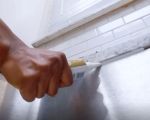
May 02, 2025
Safe Ways to Remove Old Paint from Wood
1. Understanding the Importance of Safe Paint Removal
If you’ve ever tackled a DIY project that involved stripping old paint from wood, you’ve probably faced the challenge of doing so without damaging the wood or exposing yourself to harmful chemicals. When I first started restoring furniture, I found the process both exciting and daunting. Removing layers of old paint, especially from wooden surfaces, requires careful attention to avoid damage to the wood and to ensure a safe working environment.
Many traditional paint removers contain harsh chemicals like methylene chloride, which can be harmful to both your health and the environment. Over time, I’ve learned that there are safe, effective methods to strip paint from wood that don’t involve toxic chemicals. In this article, I’ll share the techniques I’ve used to safely remove old paint from wood, along with tips to ensure your project goes smoothly.
2. Why Safe Paint Removal Matters
Removing old paint is essential for restoring wooden surfaces, whether you’re refinishing an old piece of furniture, updating your home’s woodwork, or preparing wood for a new coat of paint. However, the process can be fraught with challenges if you use harsh chemicals or improper techniques. Using safe and eco-friendly methods is not only better for your health but also for the longevity of the wood you’re working on.
In my experience, using safer alternatives has made a noticeable difference in the quality of my work. Whether it's sanding, using natural solvents, or opting for non-toxic paint removers, I’ve found these methods to be more effective and less damaging than traditional harsh chemicals. Plus, they align better with my values of reducing exposure to toxic substances.
3. Safe and Effective Methods to Remove Old Paint from Wood
Over the years, I’ve experimented with various methods for paint removal, and these are some of the safest and most effective techniques I’ve found. Each method has its own set of benefits, so it’s important to choose the one that works best for your specific project.
3.1 Using Natural Solvents
One of the safest ways to remove paint from wood is by using natural solvents such as citrus-based removers or soy-based gel removers. These products are non-toxic and biodegradable, making them a great alternative to harsh chemical paint removers. I remember using a citrus-based gel remover on an old wooden table I was restoring, and it worked wonders. The gel adhered to the paint, allowing it to lift off in chunks without damaging the wood.
Citrus-based solvents are gentle yet effective at removing paint. They are typically easy to apply and require little more than a plastic scraper or a cloth to wipe away the loosened paint. I’ve found that these types of removers are perfect for smaller projects, like refinishing a piece of furniture or removing old trim paint.
3.2 Sanding
If you’re dealing with thick layers of paint, sanding can be a great option. I often use this method when removing old paint from flat wooden surfaces. Sanding allows for precision and control, especially when dealing with smaller details like intricate carvings or fine woodwork. I personally prefer using an electric sander for larger surfaces, but for detailed work, a manual sanding block does the trick.
Sanding not only removes the paint but also smooths the wood surface, which is essential if you're planning to repaint or stain the wood. When sanding, be sure to start with a coarser grit paper and work your way up to finer grits for a smooth finish. One thing I’ve learned is to always wear a dust mask to avoid inhaling any dust particles.
3.3 Steam Strippers
For those looking for a more hands-off approach, steam strippers are another excellent option. These devices use hot steam to soften paint, making it easier to remove without harsh chemicals. I used a steam stripper when restoring a large wooden door, and it worked surprisingly well. The heat penetrated the paint, causing it to bubble up, and all I had to do was gently scrape it off with a putty knife.
Steam stripping is ideal for delicate wooden surfaces because it doesn’t use any chemicals that could cause damage. It’s also a good option if you’re working on a large area where scraping by hand might be too time-consuming. The only downside is that it requires access to a steam stripper machine, which might be an investment for some.
3.4 Using Baking Soda and Water
For a completely natural and non-toxic paint removal solution, you can create a paste using baking soda and water. This method is perfect for smaller, less detailed projects. I’ve used this technique on smaller wooden surfaces with good results. Simply mix water and baking soda to form a thick paste, apply it to the paint, and let it sit for about 30 minutes. Afterward, scrape the paint off gently using a plastic scraper.
This method is simple, cost-effective, and completely safe. The key to success with this technique is to ensure that the paste doesn’t dry out too quickly, so you may need to reapply the mixture in sections.
4. Tips for Protecting Yourself During the Paint Removal Process
While removing old paint from wood is an exciting project, safety should always be a priority. Here are a few tips I’ve learned to protect myself during the process:
4.1 Wear Protective Gear
Whether you’re using natural solvents, sanding, or steaming, it’s essential to protect yourself. Always wear gloves to protect your hands from paint removers or abrasives. Additionally, goggles or safety glasses will shield your eyes from dust or flying paint chips. I’ve found that wearing a good-quality respirator mask is especially important when sanding or working with older paint, as it may contain harmful lead, especially in vintage furniture.
4.2 Work in a Well-Ventilated Area
Even when using non-toxic paint removers, it’s crucial to ensure adequate ventilation. I make it a point to work in well-ventilated spaces or even outside if possible, especially when using products with strong citrus or solvent-based smells.
4.3 Test for Lead
If you’re working on older furniture or wood that may have been painted before 1978, it’s important to test for lead in the paint. Lead exposure can be harmful, so always use a lead-testing kit if you suspect the paint might contain lead. I’ve found this step to be crucial when restoring older pieces, and it has saved me from potential health risks.
5. Conclusion
Removing old paint from wood doesn’t have to be a difficult or dangerous task. By choosing the right methods and using safe, non-toxic products, you can successfully restore your wooden surfaces without compromising your health or the environment. Whether you decide to use natural solvents, try steam strippers, or go the DIY route with baking soda, each method can help you achieve great results.
If you’re interested in learning more about the tools and techniques I’ve used for safe paint removal, or if you’re looking for professional advice on your next project, check out the resources at ToolNest for additional recommendations.








